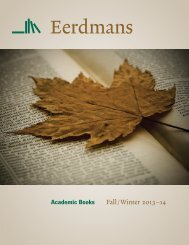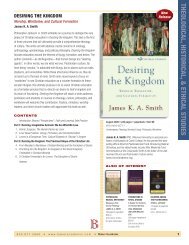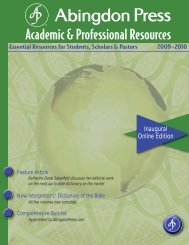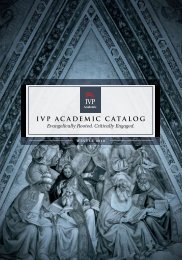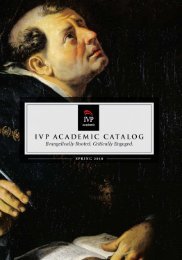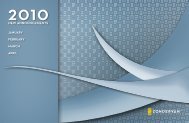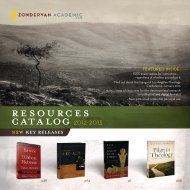koinonia
new releases
new releases
Create successful ePaper yourself
Turn your PDF publications into a flip-book with our unique Google optimized e-Paper software.
Tradition locates the Last Supper in the Cenacle on Mount Zion. This present structure was<br />
reconstructed by Franciscans in 1335. Left: The Cenacle exterior view. Above: Interior view of<br />
the Upper Room.<br />
that israel’s blindness was in fulfillment of Scripture and was part<br />
of israel’s rebellious history (12:40; mark 4:12; matt. 13:14 – 15;<br />
luke 8:10; acts 28:26 – 27). Verses 44 – 50 summarize Jesus’<br />
teaching in this first half of the gospel. he has come to reveal the father who sent him and<br />
to bring light to the world. those who reject him are condemned, but those who believe<br />
receive eternal life.<br />
The Book of Glory (13:1 – 20:31)<br />
Story time slows dramatically at this point, and the next five chapters contain Jesus’ teaching<br />
during the last Supper. While the Book of Signs (chaps. 1 – 12) concerned Jesus’ selfrevelation<br />
to the world, the Book of glory begins with private teaching for his disciples.<br />
The Last Supper (Chap. 13). the account starts with the evening meal — probably the<br />
Passover 7 — during which Jesus washes the disciples’ feet (13:1 – 17). When Peter, appalled<br />
that Jesus would act like a lowly servant, at first refuses to let Jesus wash his feet, Jesus<br />
teaches that all who follow him must imitate his model of self-sacrificial love and ser vice<br />
(13:12 – 17). two negative examples of discipleship follow, as Jesus predicts Judas’s betrayal<br />
and Peter’s denial (13:18 – 30, 36 – 38). Johannine symbolism is apparent as Judas departs<br />
and the narrator adds, “and it was night” (13:30). Between these two failures of discipleship<br />
(in a kind of inclusio) Jesus gives the disciples a new command: to love one another. By this<br />
love, all people will know they are his disciples (13:35). though not wholly original (see<br />
lev. 19:18), the command to love is new in that it sums up and epitomizes the whole law<br />
(cf. matt. 22:37 – 40). love is the hallmark of chris tian discipleship throughout the Johan-<br />
Figure 11.2—Key influences on Rudolf bultmann<br />
7. See the discussion of this passage in chapter 12, (pp. 393–94).<br />
bultmann’s perspective<br />
• Almost nothing can be known about the<br />
322<br />
J. Weiss:<br />
historical Jesus, except that he was an<br />
Jesus as<br />
apocalyptic prophet who proclaimed the<br />
Apocalyptic Prophet<br />
kingdom of God.<br />
Martin Kähler:<br />
• The early church was interested not in the<br />
031022697x_4portraits_pt3.indd 322<br />
Distinguishing the<br />
Jesus of history but 3/23/10 in 2:45:23 the Christ PM of faith,<br />
Jesus of History from<br />
speaking through the prophets.<br />
the Christ of Faith<br />
• In the early communities, the Gospel<br />
D. F. Strauss:<br />
stories were created and embellished<br />
The Gospels as Myth,<br />
with legend and myth.<br />
not History<br />
W. Wrede:<br />
• The Gospels are not historical biographies<br />
The Messianic<br />
but theological propaganda created to<br />
Secret in Mark<br />
reflect the community’s beliefs.<br />
• As the stories passed from a Jewish to a W. Bousset and the<br />
Hellenistic environment, Jesus’ status was History of Religions<br />
slowly exalted from a Jewish Messiah to a School<br />
Hellenistic Lord and Son of God.<br />
Form criticism was<br />
• Form criticism is used to analyze the<br />
developed by H.<br />
communitys’ creative activity and<br />
Map 11: JESUS’ MINISTRY Gunkel for the Old<br />
“ demythologize” the New Testament.<br />
Testament and<br />
A B C D<br />
Existentialist<br />
applied to the New<br />
International transportation<br />
• New Testament truth found not in the<br />
Philosophy of<br />
artery<br />
Mt. Testament by Bultmann,<br />
Schmidt, and<br />
Regional roadway<br />
Jesus of history but in an existentialist<br />
M. Heidegger<br />
1<br />
Hermon<br />
Transfiguration?<br />
1<br />
(possible site)<br />
Tyre<br />
encounter with the Christ of faith.<br />
Predicts his death<br />
Dibelius.<br />
Heals Canaanite<br />
Caesarea Philippi<br />
woman’s daughter<br />
Heals the centurion’s servant,<br />
a paralytic, and Peter’s<br />
T he Great<br />
Sermon on mother-in-law; restores<br />
Sea<br />
the Mount? Jairus’s daughter to life<br />
Kähler’s work has an interesting modern parallel in the writings of luke Timothy<br />
2<br />
Bethsaida<br />
Ptolemais<br />
2<br />
Korazin<br />
(Julias)?<br />
Heals<br />
blind b n man;<br />
feeds 5,000?<br />
Capernaum<br />
Johnson, a roman Catholic scholar who offers a scathing critique of the radical conclusions<br />
Bethsaida (Galilee)<br />
lee)<br />
Turns water<br />
Magdala Sea of<br />
of the Jesus Seminar (see fig. 11.3) while rejecting altogether the legitimacy of a historical<br />
into wine<br />
Galilee<br />
Heals man with demons<br />
Cana a of Galilee<br />
Gergesa es<br />
(Kursi)<br />
(Mk 5:1; Lk 8:26)<br />
Tiberias<br />
quest for Jesus. 10<br />
Mt. Tabor<br />
Heals men with<br />
Spends boyhood Nazareth<br />
are<br />
Gadara<br />
ara<br />
demons (Mt 8:28)<br />
10. luke Timothy Johnson, The Real Jesus: The Misguided Quest for the Historical Jesus and the Truth of the<br />
Nain<br />
Bethany<br />
Traditional Gospels (San francisco: HarperSanfrancisco, 1996).<br />
3<br />
Restores widow’s<br />
beyond<br />
(Possible site?)<br />
3<br />
Transfiguration<br />
Caesarea<br />
son to life<br />
(traditional site)<br />
Jordan?<br />
Maritima<br />
354<br />
Salim?<br />
SAMARIA<br />
Talks with<br />
woman at<br />
Gerasa<br />
well<br />
Sychar<br />
4<br />
Mt. Gerizim<br />
4<br />
Heals blind Bartimaeus;<br />
Ascends into<br />
calls Zacchaeus down 031022697x_4portraits_pt4.indd Tempted?<br />
354<br />
3/23/10 3:42:55 PM<br />
heaven<br />
from tree<br />
Clears<br />
Temple<br />
Jericho<br />
Baptism<br />
Emmaus<br />
Mt. of<br />
(traditional site)<br />
Olives<br />
Jerusalem<br />
em<br />
Bethany<br />
5<br />
beyond Jordan?<br />
5<br />
Bethany<br />
Raises Lazarus from dead;<br />
Appears to two<br />
Bethlehem<br />
ehem<br />
anointed in Simon the<br />
after resurrection<br />
Leper’s house<br />
10,000 ft 3050 m<br />
Birth<br />
Machaerus<br />
Crucifixion and<br />
resurrection<br />
Salt<br />
5000 ft 1525 m<br />
Sea<br />
2000 ft 610 m<br />
0 10 km.<br />
6 0 10 miles<br />
6<br />
1000 ft Map 305 of m Israel showing<br />
0 (sea level) significant 0 (sea level) events in<br />
-1640 ft -500 m<br />
Jesus’ life<br />
A B C D<br />
after his birth, though he does not mention an extended stay in Bethlehem or the sojourn<br />
in egypt (luke 2:39). as we have seen, it is common for the Gospel writers to abbreviate,<br />
condense, or skip over events which were not important to their theological purpose.<br />
J<br />
U<br />
M E<br />
according to the Gospels, Jesus had four brothers — James, Joseph, Judas, and Simon — and<br />
at least two sisters (Mark 6:3; Matt. 13:55 – 56). There is a lively debate concerning the<br />
actual relationship of these siblings. roman Catholic theologians have traditionally followed<br />
the interpretation of Jerome that these are not true brothers and sisters but cousins.<br />
031022697x_4portraits_pt4.indd 419<br />
D E A<br />
Jordan R.<br />
Jabbok R.<br />
R.<br />
D EBaptism<br />
419<br />
3/23/10 3:48:22 PM<br />
New Testament<br />
biblical studies<br />
usd $44.99<br />
Hardcover • 560 pages<br />
ISBN 9780310226970<br />
Four Portraits,One Jesus<br />
A Survey of Jesus and the Gospels<br />
Mark L. Strauss<br />
“This is the best textbook available for a course on Jesus and the Gospels. Rarely do both the<br />
instuctor and the students rave about the textbook.”<br />
—E. Randolph Richards, Palm Beach Atlantic University<br />
Four Portraits, One Jesus is a thorough-yet-accessible introduction to these documents and their<br />
subject: the life and person of Jesus. With clarity and insight, Mark Strauss illuminates these four<br />
books, first addressing their nature, origin, methods for study, and historical, religious, and cultural<br />
backgrounds. He then moves on to closer study of each narrative and its contribution to our<br />
understanding of Jesus, investigating things such as plot, characters, and theme. Finally, he pulls it<br />
all together with a detailed examination of what the Gospels teach about Jesus’ ministry, message,<br />
death, and resurrection, with excursions into the quest for the historical Jesus and the historical<br />
reliability of the Gospels.<br />
mark l. strauss (PhD, University of Aberdeen) is professor of New Testament at Bethel Seminary<br />
in San Diego, California.<br />
DIGITAL<br />
FORMATS<br />
book<br />
• Chapter quizzes • Guided readings for each gospel<br />
• Test bank • Image/map library • Flashcards*<br />
• Presentation slides • Chapter videos* • Quizzes*<br />
64<br />
Richard Strauss<br />
Part Three:<br />
The Four Gospels<br />
JeSuS’ faMIlY lIfe<br />
I D U M E A<br />
P H O E N<br />
I C<br />
G A L I L E E<br />
J U D E A<br />
I A<br />
P E R E A<br />
D E C A P O<br />
Part Four:<br />
The Historical Jesus<br />
L I S<br />
Chapter Fourteen:<br />
Jesus’ Birth and Childhood<br />
© Neal Bierling/Zondervan Image Archives<br />
Contents<br />
Part One: Introduction to the Four Gospels<br />
1. What Are the Gospels?<br />
2. Exploring the Origin and Nature of the Gospels:<br />
Historical-Critical Methods of Gospel Research<br />
3. Reading and Hearing the Gospel Stories: Literary-Critical<br />
Methods of Gospel Research<br />
Part Two: The Setting of the Gospels<br />
4. The Historical Setting of the Gospels<br />
5. The Religious Setting: First-Century Judaism<br />
6. The Social and Cultural Setting of the Gospels<br />
Part Three: The Four Gospels<br />
7. Mark: The Gospel of the Suffering Son of God<br />
8. Matthew: The Gospel of the Messiah<br />
9. Luke: The Gospel of the Savior for All People<br />
10. John: The Gospel of the Son Who Reveals the Father<br />
TextbookPlus.Zondervan.com<br />
Part Four: The Historical Jesus<br />
11. Searching for the Real Jesus<br />
12. The Historical Reliability of the Gospels<br />
13. The Contours and Chronology of Jesus’ Ministry<br />
14. Jesus’ Birth and Childhood<br />
15. The Beginning of Jesus’ Ministry<br />
16. The Message of Jesus<br />
17. The Miracles of Jesus<br />
18. The Messianic Words and Actions of Jesus<br />
19. The Death of Jesus<br />
20. The Resurrection of Jesus<br />
Conclusion<br />
Glossary<br />
Index<br />
Order FREE exam copies (instructors only)



